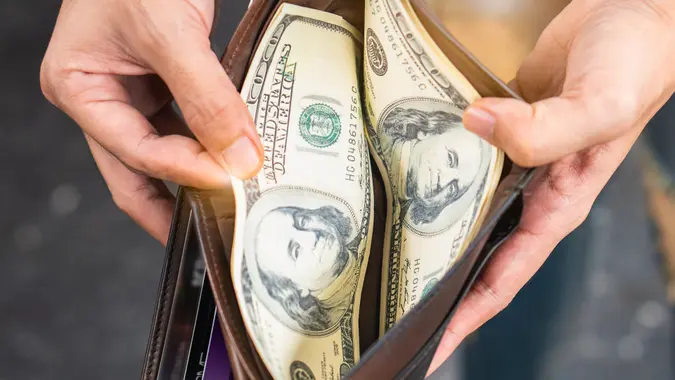This ‘Invisible Money’ Hack Helps You Save Without Even Trying

Commitment to Our Readers
GOBankingRates' editorial team is committed to bringing you unbiased reviews and information. We use data-driven methodologies to evaluate financial products and services - our reviews and ratings are not influenced by advertisers. You can read more about our editorial guidelines and our products and services review methodology.

20 Years
Helping You Live Richer

Reviewed
by Experts

Trusted by
Millions of Readers
Saving money is a lot easier said than done, especially as the increased cost of living is stretching Americans’ paychecks to the breaking point. For many people, the hardest part of saving is simply getting started. That’s where micro-savings apps come in.
These apps quietly deposit small amounts of money into savings accounts by using smart features like rounding up purchases, skimming a few dollars from your paycheck, or canceling unused subscriptions. If you’ve struggled to build an emergency fund or start saving for the future, this invisible money hack could be the easiest way to kick-start your financial goals.
How Micro-Savings Apps Work
Most micro-savings apps operate on the fact that you won’t miss these small amounts, but the deposits add up over time. The most common feature is roundups. For example, say you buy a $4.57 latte, the app rounds it up to $5, moving the spare 43 cents into a savings or investment account. Other features include automatic paycheck transfers, overdraft protection and even the option to invest small sums in exchange-traded funds (ETFs).
Many of these apps don’t impose minimum fees or withdrawal limits, either, which can make them accessible for low-income families, students and anyone who struggles to save consistently.
Why They Matter
Americans are so busy trying to stay afloat, they often struggle to save. According to a GOBankingRates survey, half of Americans have less than $500 in savings.
Micro-savings apps can help people who feel like they have little to no room in their budgets make a dent in savings goals. Instead of requiring discipline to stash away cash or force extreme budget cuts, these tools make saving passive and automatic.
Who Can Benefit
Micro-savings apps are versatile enough for almost anyone:
- Students and young adults: The earlier you save, the more you can benefit from compound interest for decades if you stick it in high-yield savings or invest it.
- Families: Parents can use apps to teach kids about money or even turn savings into a family competition, working toward shared goals like vacations.
- Busy professionals: For people who don’t want to think about saving, automated transfers ensure it happens in the background.
The appeal of micro-savings apps is clear:
- They’re easy to use.
- They take the work out of saving through automation.
- No or low minimum deposits
- Motivation from seeing progress build
- In some cases, FDIC insurance
Of course, they aren’t the only tool people should be using to save. Saving $10 a week won’t be enough for retirement or even a robust emergency fund, but they’re a good start in lean times.
Long-Term Impact of Small Savings
The real magic of these apps lies in consistency. A 25-year-old who saves just $100 per month with a 4% return in a high-yield savings could accumulate nearly $118,000 by age 65. Invested in higher-yielding financial products or accounts, that could net significantly more over time. While micro-savings apps won’t make you rich, they can help build a cushion.
Some Micro-Savings Apps To Consider
A few standout options include:
- Acorns: Rounds up purchases and invests spare change. Acorns puts money into a diversified portfolio based on retirement age and risk tolerance.
- Oportun: Analyzes income and expenses, then automatically withdraws money for savings goals.
- Goodbudget: A digital envelope budgeting system for families who want structure.
- Chime: Offers automatic paycheck savings, no fees and early direct deposit.
- Albert: A full-service app with saving, investing and budgeting tools, though subscriptions cost $11.99 to $29.99 monthly.
- Rocket Money: Helps manage subscriptions, track spending and negotiate bills.
Kick-Starting Good Habits
Micro-savings apps won’t replace a retirement account or emergency fund, but they can kick-start the habit of saving and help people who might otherwise feel challenged to carve out savings.
Whether you’re a student, parent or professional, the “invisible money” hack makes saving less intimidating and more achievable. Try one app for a month, and you might be surprised at how quickly that spare change adds up.
Caitlyn Moorhead contributed to the reporting for this article.
 Written by
Written by  Edited by
Edited by 
























